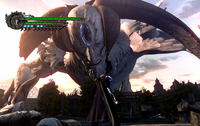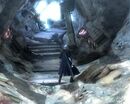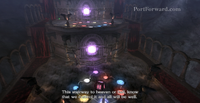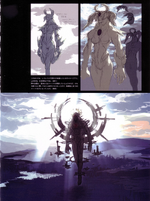- MAIN
- Gallery
The Savior is a gargantuan statue of the Dark Knight Sparda, brought to life by the Order of the Sword,[2] which appears in Devil May Cry 4. It was brought forth by the Order of the Sword so that it can be used to conquer the world and purge it of demons and was housed in the Advent Chamber until it was awakened. Nero first encounters the Savior in Mission 11: The Ninth Circle, and Dante battles it in Mission 18: The Destroyer.
Description[]
The Savior is a large, humanoid statue designed to resemble the Order of the Sword's idealized concept of Sparda. The Savior has feathery embellishments on its head, neck, shoulders, wrists, calves and midriff giving it an angelic appearance and its horns appear more regal and majestic than the insectoid antlers that Sparda possessed. Though it is a demon, it is looked upon by the citizens of Fortuna as a god and its exterior holds several azure jewels composed of a millennia's worth of demonic and spiritual essence melded together.[2] When activated by Sanctus it gains a giant, partially formed halo that resembles a set of wings.
Story[]
Devil May Cry 4[]
In order for the Savior to be activated, it must absorb one with the blood of Sparda, and it can then be controlled by one who carries his ancient sword. To this end, the Order endeavored to lure in Dante by retrieving the Yamato and opening the Hell Gates. Not only did Dante come to Fortuna, but his partner Trish brought them the Sparda sword in an attempt to infiltrate their organization. However, they were unable to capture Dante fast enough, and instead decided to use Nero as the Savior's source of blood. Sanctus managed to lure Nero to the Savior's resting place by kidnapping Kyrie, and tried to convince him to be absorbed by having the statue also absorb her. Though he refused and tried to fight back, he was ultimately taken in by the Savior, and Sanctus took the Yamato from him.
In control of the awakened Savior, Sanctus had Agnus open the true Hell Gate with the Yamato, and with the aid of the Order's 'Angels' destroying the escaping and invading demons in a show to convince the citizens of Fortuna it was their messiah. However, Dante followed the Savior back to town, and not only did he destroy the minor Hell Gates on the way, but he was able to retrieve the Yamato and destroy the true Hell Gate as well. He was confronted by Sanctus and the Savior in the sky above Fortuna, but was able to weaken it by destroying the jewels on its surface. He then helped Nero escape from the heart by giving him back the Yamato. Nero then proceeded to the statue's Sacred Heart, where he defeated the ascended Sanctus, and rescued Kyrie.

Nero battles the False Savior
With Sanctus defeated, the Savior is rendered into an immobile statue. As Dante, Nero, and Kyrie return to town, Sanctus remains are suddenly assimilated by the Savior which reawakens as The False Savior (偽神 Nisegami?), and taking on his facial features with his plans ruined he faces Nero again.[3] However, Sanctus by himself is shown to be a weaker power source than Nero and Kyrie (hence the "False" title). After overpowering its powerful but slow and clumsy fists with his Devil Bringer, Nero jumps high in the air and uses the Devil Bringer to grab on the False Savior's head. As he tries to rise back up, Nero tightens his grip and pulverizes the False Savior's face into a cloud of grey dust, destroying both Sanctus and the Savior once and for all. After losing its face, the False Savior is seen collapsing to the ground.
Inside the Statue[]

Machina Ex Deus
The Savior's inner chambers consist of a palatial stairway from the organ in which Nero was kept to the heart of the Savior itself, where Sanctus Diabolica resides. Each level of the stairway contains a Dice Game that unlocks the door to one of the Savior's inner Heavens—lairs where Nero is forced to fight apparitions of previously defeated bosses. These Heavens can also be accessed by any of the purple circles on other Dice Games.
- Sky Above Fortuna: The floating platforms above Fortuna where Dante fights with the Savior.
- Machina Ex Deus (Lat: "Machine out of a god"): A strange hallway with demon eyes growing in the stone walls and stone pillars surrounding the stairs.

Stairway to Heaven
- Stairway to Heaven: An ornate stairway within a gigantic, living cavern. The terraces at every floor contain angelic statues used as lampposts, as well as Dice Games.
- Heaven: Arma (Lat: "Armor"): First Heaven, lair of Angelos and mimicking the battleground of the fight with Angelo Credo.
- Heaven: Ignis (Lat: "Fire"): Second Heaven, lair of Berial.
- Heaven: Nix (Lat: "Snow"): Third Heaven, lair of Dagon.
- Heaven: Draco (Lat: "Dragon"): Fourth Heaven, lair of Echidna.
- Heaven: Vermis (Lat: "Worm"): Fifth Heaven, lair of Angelo Agnus.
- Sacred Heart: The heart of the Savior itself, and lair of Sanctus Diabolica.
Powers & Abilities[]
The Savior, once awakened, is one of the most powerful monsters in the series, as the Savior can protect its user and wields immeasurable power, as well as the ability to fly. Despite its size, it proves to be quite agile when it tries to smash Nero or sweep Dante off the floating rubble, itself levitated due to the sheer power of the Savior's aura. However, it truly shines in its demonic power. Wielding the rare power of light, the Savior can summon bolts of light energy that can easily wipe out masses of demons, as if smiting them like a god. It can also fire orbs of darkness and as well as explosive blasts of energy as well. Its most fearsome attack is a massive beam of concentrated destructive energy. On its legs, chest, head, shoulders and hands contain thousands years worth of both demonic essences, which serve as a weak point of sorts. However, despite the loss of its jewels, it can still use its demonic powers. Although on the outside it appears as a figure of holy significance, its interior houses an entire dimension of demonic origin. As a vessel for Sanctus, he is able to emerge from any part of the golem's body at will.
Weaknesses[]
Being made of stone, its exterior is tough and seemingly impervious to any damage. Despite this, Dante found a way to weaken Savior by destroying the jewels around its body. This process makes it more vulnerable to Dante's weapons. Dante manages to weaken the Savior enough for him to hand over Yamato to Nero through a hole in the chest jewel. After Nero's victory over Sanctus, the Savior falls from the sky and is unable to use its powers. This opportunity allows Nero to grab the Savior's head with his Devil Bringer arm and pulverize it.
The Savior cannot be damaged by normal means, hence it can only be hurt by using demonic weapons against it, like Yamato and Rebellion. It cannot be damaged when using man-made weapons such as the Red Queen or the Blue Rose.
Background[]
In many religions, a savior is a figure who helps his or her followers achieve salvation at the end of days. In the Abrahamic faiths, the Savior is also referred to as a messiah, and usually refers to Jesus of Christianity.
The role of The Savior in the game is an allusion to "The False Prophet" in the Book of Revelation from the Bible. Such similarities are their angelic appearance, yet demonic in nature. Moreover, the propaganda of Sanctus in deceiving the people of Fortuna, parallels the False Prophet's agenda to deceive people by means of fake "miracles" into worshiping the Beast.
Trivia[]

Early concept of the Savior, depicted as a female.
- Early concept sketches in the Devil May Cry 4 Devil's Material Collection artbook show that a female design for the Savior was considered.
- It's also stated that at first the statue height was supposed to be 50 meters, but it was changed to 150 meters after the developer placed it near the town which proved it to be unexpectedly small.
- In the Devil May Cry: 3142 Graphic Arts book, it's stated that at first the Savior had 100,000 polygons, but that was eventually changed to around 60,000 - 70,000.[4]
- The Savior's beam attack is similar to Dante's UDT beam attack Laevateinn in Devil May Cry 2.
- The Savior bears some resemblance to main antagonist of Bayonetta, Jubileus, the Creator: both are portrayed as gigantic living statues regarded by their followers as "gods"; both were constructed in the center of a tall skyscraper structure; both must absorb one of the main characters to be activated; both are final bosses in their respective games; and both are defeated by the efforts of two main characters.
- Also, in Bayonetta: Bloody Fate after Bayonetta is freed from Jubileus, her body has more resemblance to the Savior and has more similarities to the False Savior as Balder like Sanctus takes control of the half powered Jubileus after Bayonetta is freed.
- The Savior is very similar to Mundus in terms of combat, which is ironic as it was built to resemble Sparda.
- The Savior is also very similar to Mundus in appearance, since they both are white, gargantuan god-like statues. Furthermore, the Savior's forehead jewel somewhat resembles a third eye similar to Mundus'.
- The Savior in Mission 18 is the only boss in Devil May Cry 4 exclusively fought by Dante.
References[]
- ↑ Devil May Cry 4 Official website
- ↑ 2.0 2.1 Devil May Cry 4, Boss File — The Savior: "The most powerful demon brought forth by the Order of the Sword. Its exterior, oft-mistaken to be a god, holds a millennia of demonic matter and spirit melded together. With the blood of Sparda and his ancient sword, it will be possible to control the Savior for the first time."
- ↑ Devil May Cry 4, Boss File — The False Savior: "Completely assimilating the body of Sanctus, the False Savior may fall short of a true god’s power; however, its repulsive tenacity means one must not let their eyes stray from it for too long. Bring forth final judgment upon this atrocity!"
- ↑ Devil May Cry: 3142 Graphic Arts. p.131